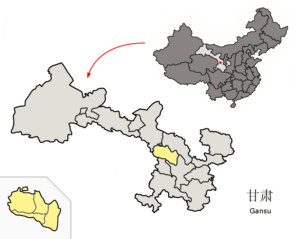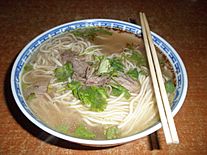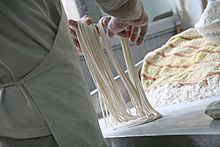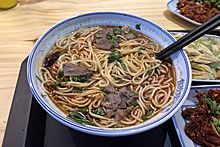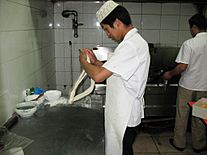Lanzhou beef noodle soup facts for kids
Lanzhou beef noodle soup (兰州牛肉面) is a super tasty type of beef noodle soup. It comes from China and has a long, interesting history. The way it's made can be a little different depending on where you are, because of local traditions and ingredients.
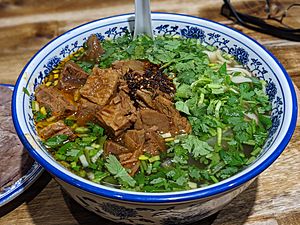
Lanzhou beef noodle soup
|
|
| Type | Noodle soup |
|---|---|
| Region or state | East Asia and Southeast Asia |
| Main ingredients | Beef, beef broth, vegetables, Chinese noodles |
| Lanzhou beef noodle soup | |||||||||||||||||||||||||
|---|---|---|---|---|---|---|---|---|---|---|---|---|---|---|---|---|---|---|---|---|---|---|---|---|---|
| Traditional Chinese | 蘭州牛肉麵 | ||||||||||||||||||||||||
| Simplified Chinese | 兰州牛肉面 | ||||||||||||||||||||||||
| Literal meaning | Lanzhou Beef noodles | ||||||||||||||||||||||||
|
|||||||||||||||||||||||||
History of Lanzhou Noodles
One of the oldest beef noodle soups is called Lanzhou hand-pulled noodle or Lanzhou lamian. It was first made by the Hui people in northwest China. This happened a very long time ago, during the Tang Dynasty.
Even though people discuss exactly when it started, the recipe is named after Lanzhou, a big city in Gansu Province. Lanzhou is located by the Yellow River. It was also an important stop on the ancient Silk Road, a famous trade route. The Hui Muslim people created a special beef noodle soup. It fit their Muslim diet and used ingredients that were easy to find.
You can find many kinds of beef noodle soups in China. There are more different types in Western China than in East China.
What Makes the Dish Special?
Lanzhou beef noodle soup is a Chinese Muslim style of soup. It is also known as clear-broth beef noodle. This soup often uses halal meat, which means it's prepared in a special way. It usually does not have soy sauce. This gives it a lighter taste. Salt and herbs are used to add flavor.
A local story says a Hui Chinese man named Ma Baozi created this dish. In Lanzhou, the capital of Gansu province, Lanzhou Beef Lamian is usually served with clear soup. Each bowl has one hand-pulled lamian noodle. In halal restaurants, they only use good quality local beef. This beef comes from Southern Yellow cattle. It is prepared by a local halal butcher.
Chinese radish and a special spicy oil are also important parts of Lanzhou beef noodles. To help people know what to look for, the local government suggests five steps. These steps describe how the soup should look: "One Clear, Two White, Three Red, Four Green, Five Yellow."
- First, the beef soup should look very clear.
- Second, the radish slices should be crystal white.
- Third, the chili oil should be a bright red color.
- Fourth, the green cilantro leaves and garlic shoots should be like jade.
- Lastly, the noodle should be smooth and bright yellow.
You can find this food in Chinese restaurants in North America. In Mainland China, a large bowl of it is often eaten as a whole meal. Sometimes people have side dishes with it, and sometimes not.
Different Styles of Lanzhou Noodles
Traditional Lanzhou beef soup noodles can be made in eight different styles. These styles are based on the noodle's thickness and shape.
- Thinnest (毛细) is a round noodle, about two-thirds as thick as spaghetti.
- Thinner (细面) and Thin (三细) are about the size of spaghetti.
- Thick (二细) and Thicker (粗面) are round noodles, thicker than the thin styles.
- Prism (韭叶), Wide (宽面), and Wider (大宽) are flat, thin noodles. They offer a different texture.
- A newer type is Qiaomaileng (荞麦棱). This noodle is special because of its angular, or cornered, shape.
Many restaurants around the world offer these noodle styles. This is because noodle making has changed over time. Also, local cultures have added their own twists. According to omnivore's cookbook, Lanzhou hand-pulled noodles should be even in width and thickness. The ingredients should also be prepared in certain sizes.
In mainland China, some restaurants let customers watch how the noodles are made. It's like seeing a food production line. The dough for the hand-made noodles is usually prepared the day before. However, the noodles are pulled into shape fresh on the day they are cooked. The noodle pulling process is very fast. It only takes a few minutes. It involves rolling, pulling, and spinning the dough many times. Right after the noodle is shaped, it is boiled until it is fully cooked.


